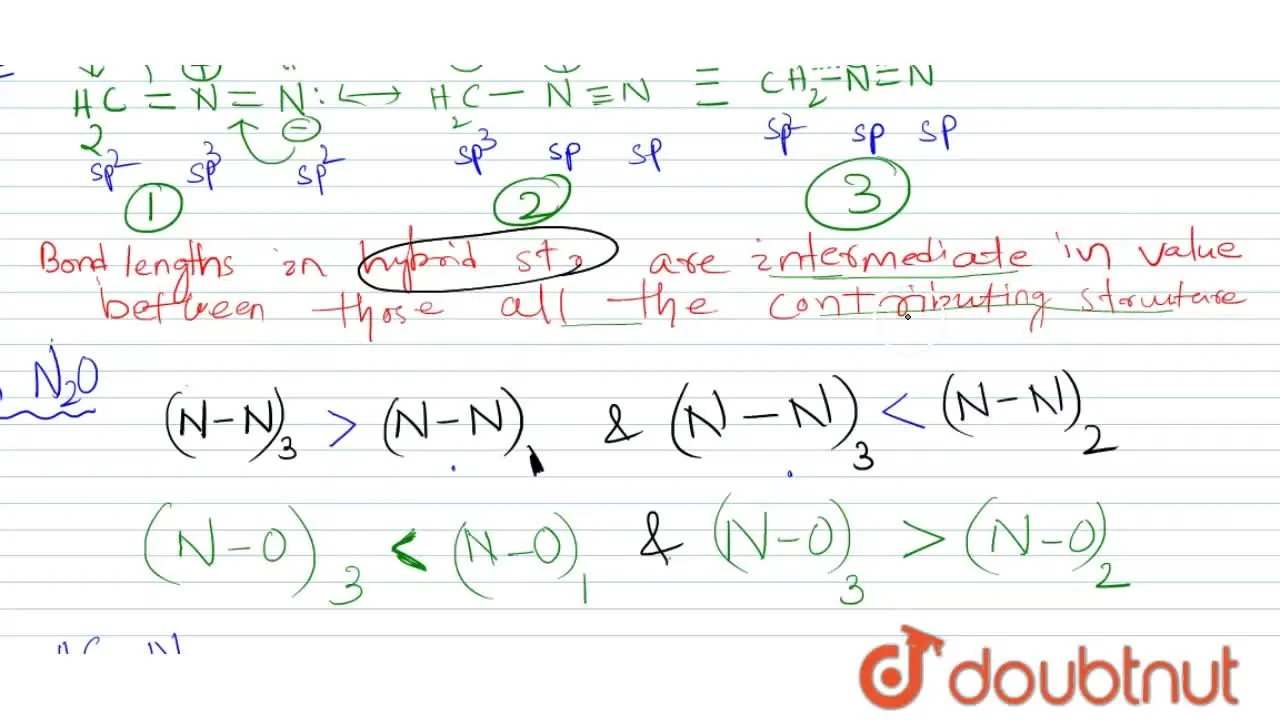(a) Write the resonance structures of NOӨ2 (nitrite) and NOӨ3 (nitrate ion) in terms of :
(i) outer shell ¯e,s with formal charges
(ii) overlapping atomic orbitals.
( c) Compare the resonance (delocalisation) energy adn stabilities of NOӨ2 and NOӨ3.
(b) (i) Write the resonance contributing and hybrid structures of (I) N2O (II) H2C−N2 (diazomethane).
(ii) Give the hybridised state of each atom in each structure.
(iii) Discuss their bond length in each resonance contributing structure and compare with those in hybrid structures.

In the resonance hybrid structures, dashed-line bonds are used to indicate double or triple bond character between the bonded atoms. These partial multiple bonds represent the expanded π−bond overlap. In each resonance contributing structures, the negative charge resides on a different O atom But in the hybrid structures, each O atom has a fractional negative charge.
(ii) NOӨ2 : In NOӨ2, N has three sp2 hybrid orbitals. Two of them from σ−bonds with the two O atoms and third sp2 HO has LP¯e,s. Its pure p−AO overlaps laterally with a pure p−AO of each Oatom, resulting in extended π−bond overlap, comprising both the Oatoms and the N atom, spreading charge over both the O atoms.

(FIg) Overlapping atomic orbitals NOӨ3 is similar to NOӨ2 except that a third O atom is involved in the extended π−bond with the delocalisation of the negative charge over three O atoms, resulting a (−2/3) charge on each O atom [Fig. 4.16(b)]
(iii) NOӨ3 has more delocalisation (or resonance) energy and is more stable than NOӨ2.NOӨ3 has three resonating structures in which negative charge is delocalised over all the three O atoms, whereas NOӨ2 has two resonating structures in which negative charge is delocalised over two O atoms.
The energy of the hybrid is always lower than that of any cannonocal structures. The greater the number of resonance contributing structures with similar energies, the more stable and lower is the energy of the hybrid. More similar energy resonance contributing structures result in more extanded π−bond∈g. Which allows the ¯e,s to move in a larger space and decreases ¯e,s repulsion.
(b) (i) and (ii)
Resonance structures of (N2O)(I) :
:N↑sp(I)≡⊕N↑sp−..O..:Θ↑sp3↔:ΘN↑sp2(II)=⊕N↑sp=..O↑sp2:≡−δN↑sp...=⊕N↑sp...−−δO..↑sp2:(III)(Hybride structures)
Resonance structure of (H2C−N2)(II) :
H2C↑sp(IV)≡⊕N↑sp−..N:Θ↑sp2↔H2..ΘC↑sp3(V)−⊕N↑sp≡..N↑sp≡−δH2C↑sp2=⊕N↑sp...=δ−N↑sp:(VI)(Hybrid structures)
(iii) Bond lengths in hybrid structures are intermediate in value between those all the contributing structures (i.e., standard single, double, or driple bond (value). In N2O, the (O−N) bond length in the hybrid (III) is shorter than the single bond in (I) but longer then the double bond in (II). The (N−N) bond length in the hybrid (III) is longer than in (I) but shorter than in (II). In (H2C−N2), the (C−N) bond length in the hybrid (VI) is longer than double bond in (IV) but shorter than the single bond in (V)
The (N−N) bond length in the hybrid (VI) is shorter than double bond in (IV) but longer than the triple bond in (V).
The (H−C−H) bond angle expected form (IV) is 120∘ and from (V) is 105.5∘. The actual bond angle has some intermediate value because the hybrid is a mixture of each resonating structure.
For maximum extended π−bonding, the atoms in the hybrid structure should have p−AOs. In other words, the hybrid orbitals used to form σ−bonds should have lessp character.
Therefore, C should be sp2 - like rather than sp3, and the terminal N should be sp- like rather than sp2
Since the resonating structure of both N2O (I and II) and CH2N2 (IV and V) are equally stable, so the hybrid (III) (for N2O) and hybrid (VI) (for H2CN2) is a good mixture (blend) of their corresponding resonating structures.
Related Playlists
- BOOK - CENGAGE CHEMISTRY ENGLISHCHAPTER - GENERAL ORGANIC CHEMISTRYEXERCISE - Solved Example18videos
GENERAL ORGANIC CHEMISTRY
- BOOK - CENGAGE CHEMISTRY ENGLISHCHAPTER - GENERAL ORGANIC CHEMISTRYEXERCISE - Subjective11videos
GENERAL ORGANIC CHEMISTRY
- BOOK - CENGAGE CHEMISTRY ENGLISHCHAPTER - CLASSIFICATION AND NOMENCLATURE OF ORGANIC COMPOUNDSEXERCISE - Analytical and Descriptive Type3videos
CLASSIFICATION AND NOMENCLATURE OF ORGANIC COMPOUNDS
- BOOK - CENGAGE CHEMISTRY ENGLISHCHAPTER - HYDROGEN, WATER AND HYDROGEN PEROXIDEEXERCISE - Subjective Archive (Subjective)3videos
HYDROGEN, WATER AND HYDROGEN PEROXIDE
Similar Questions
Write the resonating structures of NOΘ2 (nitrite ion) and NOΘ3 (nitrate ion) .
View SolutionWrite the resonance structures for SO3,NO2, and NOө3.
View SolutionWrite the resonance structure of CO2−3 and HCOө3.
View SolutionWrite the resonating structures of O3andCO2.
View SolutionWrite two resonance structure of N2O that satisfy the octet rule.
View SolutionWrite two resonance structure of N2O that satisfy the octet rule.
View SolutionHow many resonance structures can be drawn for the nitrate ion, NO−3?
View SolutionHow many resonance structures can be drawn for the nitrate ion, NO−3?
View SolutionDraw the resonating structure of
(i) Ozone molecule (ii) Nitrate ionView SolutionWrite the resonance structures of (1)CH3COOӨ and (2)CH2=CH−CHO. Indicate the relative stability of the contributing structures.
View Solution


